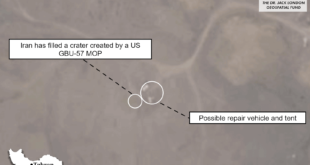NEW YORK — Numbers and words, words and numbers, repeated so many times they begin to lose meaning.
A suicide car bomber rams a military checkpoint. Police find 28 bullet-riddled bodies in shallow graves. A man walks into a restaurant and blows himself up.
And so it has come to be that photographs, in many instances, bring home the real story of death and destruction that constitutes daily life in Iraq, a year after US-led coalition forces handed over control of the country to an Iraqi government.
Western reporters are often officebound when not embedded with US troops. To step outside a fortified hotel invites being shot or kidnapped. Because of that, Iraqi photographers risk a great deal to document what is happening to their country and to their people.
To view the images captured by Associated Press photographers in June is to enter a country of sorrow: Outside a hospital in town of Tikrit, a father sits on his haunches beside his five-year-old daughter. She lies on her back on a tile floor, cushioned by a mishmash of clashing, garishly coloured sheets and blankets. A strand of dark hair falls over one eye. Her small face is peaceful, as if she were taking a nap. But there is blood under her head, discoloured from the passing of time, and an empty, collapsed IV bottle against her shoulder.
She was shot during an Iraqi army raid. She died at the hospital. Her father shields his eyes with his hand. The small of his back is braced against a stucco wall. He does not touch his little girl. The slump of his shoulders says this cannot be true; this is too much to bear.
In another hospital, this one in Baghdad, four hospital beds fill the frame, the mattresses sheathed in turquoise plastic, the headboards made of tubed metal, the kind American hospitals haven’t used in decades. On the second bed, a fan of black hair escapes a white sheet. Underneath is the body of a 10-year-old girl, killed in her neighbourhood by a roadside bomb.
Behind her, on the third bed, sits her mother, clad crown-to-toe in the extreme modesty of a black abaya. She clutches her pocketbook and looks away from her dead daughter, as if not seeing the child could somehow change reality. In the chaos of this country, car bombs are ubiquitous. In photograph after photograph, burned-out wreckages hulk under highway overpasses, straddle sidewalks, slam into the sides of tanker trucks. Depending on the type and the amount of explosive, sometimes a smoldering skeleton is left; sometimes a lone axle. Sometimes a melted chassis entombing the driver’s body.
Always, there are images of bodies. Bodies on the streets, bodies in the bombed rubble, bodies strewn across a sandy plain like toy soldiers.
From a helicopter hovering near the Syrian border, an image is made of 10 dead men, outlined by an expanse of desert. Three corpses are curled together, their hands bound behind their backs, blindfolds tied around their heads. One is missing his shoes.
The other bodies are scattered face-down in the sand, separated by several feet, apparently shot where they stood near a highway that meanders along the Euphrates River.
They are thought to have been off-duty Iraqi soldiers, dressed in civilian clothes, driving two minivans across the desert towards a vacation in Baghdad.
With the carnage also come moments of normalcy _ or near-normalcy. In Baghdad, on a Saturday, a father buys his young son a shiny bicycle in an outdoor market to celebrate the school year’s end. Both are wearing thobes, traditional, floor-length robes for males. Behind them is a long row of bikes in varying heights and colours glinting in the sunlight. The boy, who looks to be about five, is helping his father push their new purchase, though it is very small and has training wheels. The boy does not seem to mind one bit. One week later, a sandstorm hits Baghdad. Everything turns brown. An Iraqi man has tied a scarf around his face. On top of the scarf perch his sunglasses. Atop his head perches a straw hat. Not one bit of flesh is visible. He looks like the Invisible Man, when the Invisible Man decided to be visible. In another image, Iraqi soldiers from the interior ministry hold a pigeon before a photographer’s lens. They are wearing helmets and have tied cloths to obscure their faces, so insurgents won’t get a look at them should the photo make it into the local paper. The reason they’re holding the pigeon? They are inspecting the bird for wounds, after it became one of the victims of a suicide bomber.
There also are snapshots of joy amid the blood and the violence and the irony.
The friends and family of Hussein Hanoun Al Saadi — an Iraqi translator kidnapped five months ago with a French journalist — cheer and weep and smile as the released man returns home. His young son reaches out an arm. So do friends. What appears to be bugs hang in the air, suspended in time and motion by the snap of a shutter. On closer inspection, the bugs are actually small pieces of wrapped candy, thrown by the welcoming party.
 Eurasia Press & News
Eurasia Press & News



